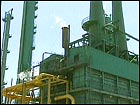|
U.S. production shrinks
|
 |
October 16, 2001: 10:17 a.m. ET
The manufacturing sector continues to bear the brunt of a slow economy.
|
NEW YORK (CNNmoney) - U.S. industrial output shrank for the 12th straight month in September, the Federal Reserve said Tuesday, pointing to more hard times for manufacturers in the world's largest economy.
Industrial production fell 1.0 percent in September, the Fed reported, after falling a revised 0.7 percent in August. The 12-month decline is the longest since the end of World War II. Economists surveyed by Briefing.com had forecast a 0.8 percent drop.
The Fed also said factories, mines and utilities ran at 75.5 percent of capacity in September, down from a revised 76.4 percent in August. Economists expected capacity utilization of 75.4 percent.
"Industrial activity is contracting across a broad set of industries, reflecting the declines in both consumer and business spending," said Steven Wood, economist with FinancialOxygen.
U.S. stocks were slightly lower in early trading while U.S. Treasury bond prices were slightly higher.
Click here for CNNmoney.com's economic calendar
The manufacturing sector has been struggling for more than a year, bearing the brunt of a protracted slowdown in the broader economy. The Fed has cut its target for short-term interest rates nine times this year in a bid to fuel growth, but many analysts say the United States sank into a recession after the Sept. 11 terrorist attacks that killed thousands and disrupted the economy for days.
Before the attacks, the economy was dragged down by slow business spending that led to a backlog of goods on manufacturers' shelves, which forced them to cut production and jobs. That situation seemed poised to improve before Sept. 11, though the rising number of job cuts was beginning to sap consumer confidence.
After the attacks, consumer spending and confidence fell, a much more ominous development for the economy -- and manufacturing -- since consumers fuel two-thirds of the U.S. economy.
"Clearly, the immediate impact of the events of Sept. 11 was negative -- from disrupted sales, air travel and production, not to mention the effect on the attitudes and expectations of consumers and businesses," Federal Reserve Vice Chairman Roger Ferguson said in a speech Tuesday in New York.
But the Fed's cut on Oct. 2 -- the ninth so far this year and the second since the attacks -- brought the central bank's target for a key short-term interest rate to its lowest level in nearly 40 years. And the President and Congress are discussing a stimulus package of tax cuts and spending likely worth about $50 billion to put money in consumers' pockets and boost confidence.
"There's a very good likelihood we'll see the sector come back as rebuilding takes place and the economy starts to react to the huge stimulus in the pipeline," said Anthony Chan, chief economist at Banc One Investment Advisors.
Like many other economists, Chan expects the economy to return to growth some time next year, with manufacturing leading the way.
"We'll start seeing solid and significant evidence of recovery in the manufacturing sector in the first quarter next year," Chan said. "It was the first to go into recession and will be the first to come out."
The Fed's report showed manufacturing activity, the largest portion of industrial production, fell 1.1 percent in September after a 0.9 percent decline in August.
Production of cars and parts fell by 3.6 percent in September, after a 3 percent drop in August. The attacks had forced some car plants to close temporarily because of supply problems.
Production of consumer goods, such as home appliances, dropped at a rate of 3.2 percent in the third quarter, the largest decline since the first quarter of 1991, when the country was suffering through its last recession. 
- from staff and wire reports
|
|
|
|
|
 |

|

